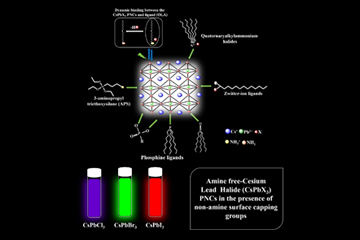 Dr Nimai Mishra, Assistant Professor, Department of Chemistry, SRM University-AP, Andhra Pradesh, accompanied by his research group encompassing students pursuing PhD under him, Mr. Syed Akhil and Ms. V.G.Vasavi Dutt have published a comprehensive mini-review titled “Amine-Free Synthesis of Colloidal Cesium Lead Halide Perovskite Nanocrystals” in the Journal “ChemNanoMat” (Wiley-VCH) with an Impact Factor of 3.4.
Dr Nimai Mishra, Assistant Professor, Department of Chemistry, SRM University-AP, Andhra Pradesh, accompanied by his research group encompassing students pursuing PhD under him, Mr. Syed Akhil and Ms. V.G.Vasavi Dutt have published a comprehensive mini-review titled “Amine-Free Synthesis of Colloidal Cesium Lead Halide Perovskite Nanocrystals” in the Journal “ChemNanoMat” (Wiley-VCH) with an Impact Factor of 3.4.
Colloidal cesium lead halide (CsPbX3) perovskite nanocrystals (PNCs) are emerging disciplines in research aided by their exceptional optical properties and remarkable colour tunability. Oleic acid and oleylamine are the frequently used surface capping ligands in colloidal CsPbX3 synthesis. The oleylamine plays an important role in surface passivation and maintaining colloidal stability. However, in the long run, it is accountable for poor colloidal stability because of the facile proton exchange. This heralds to the formation of labile oleylammonium halide, which removes the halide ions from the Nanocrystals’ surface.
 Leveraging on the synthetic toolboxes developed from decades of research into more traditional semiconductor nanocrystals, lately, researchers are focusing on creating various amine‐free synthesis approaches to improve the colloidal and photostability of CsPbX3 perovskite NCs. In this paper, Dr Mishra and his team encapsulated various amine‐free based synthetic routes of CsPbX3 (X=Cl, Br, I) PNCs that have been reported so far. They reviewed this progress in terms of their underlying synthetic approaches, and post‐synthetic treatment steps.
Leveraging on the synthetic toolboxes developed from decades of research into more traditional semiconductor nanocrystals, lately, researchers are focusing on creating various amine‐free synthesis approaches to improve the colloidal and photostability of CsPbX3 perovskite NCs. In this paper, Dr Mishra and his team encapsulated various amine‐free based synthetic routes of CsPbX3 (X=Cl, Br, I) PNCs that have been reported so far. They reviewed this progress in terms of their underlying synthetic approaches, and post‐synthetic treatment steps.
Furthermore, Dr Mishra and his group analyzed the prospects of these perovskite nanocrystals in terms of their photo‐luminescence properties and device performances. Advancing, a deeper understanding of the role of precursors and ligands will significantly bolster the versatility of these amine‐free PNC materials.
To read the full paper: Please Click Here

